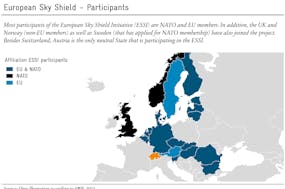Only a few states in the world are more decentralized than Switzerland. Although the country is small (41,285 square kilometres with 8,4 million inhabitants), it is politically divided into 26 cantons (equivalent to the “Länder” in Germany or the “States” in the USA) and 2,255 municipalities (“Gemeinden” in German).
Better said: the Swiss Confederation is the ultimate form of a bottom-up federal state, being the expression of the transfer of sovereignty from 26 cantons to the superior (national) level. In bottom-up federalism, institutional powers rise from the base and are transfered to the “superior” level. In a top-down approach, institutional powers are distributed from the top to the “lower” levels of the state, considered merely as administrative subdivisions.
The institutional mechanisms between Confederation, cantons and communes are quite complex. This complexity is even increased by Switzerland’s successful open-economy policy, which has to be supported by many international agreements. These sophisticated interactions have a cost, and public policies sometimes suffer from slowness and inertia. However, these transaction costs (as economists would call them) are more than counterbalanced by fundamental advantages.
Switzerland’s federal state structure enjoys a high degree of acceptance among Swiss citizens. The feeling of proximity between citizens and state is reinforced by the fact that real decisional powers can still be exercised at local and cantonal levels. To ensure that these powers are backed up by funding, fiscal sovereignty is also largely decentralized: the allocation of the fiscal income needed to cover the public expenses generated by political decisions is, as much as possible, in the hands of the decision-making public institutions.
USA, Canada and Switzerland at the top of regional fiscal autonomy
The 26 Swiss cantons enjoy significant fiscal autonomy, as they are entitled to manage nearly 25% of their total fiscal income (social insurance included).Only Canada (35%) and the USA (19,3%) have similarly high ratios for their own provinces or states.
Federalism measured to this criterion is not very vivid in Switzerland’s neighbouring States. Italy’s “Regioni” benefit from some flexibility, managing 5,5% of their total fiscal income. Although praised as a model of federalism, Germany’s Bundesländer are allowed freedom of choice on only 0,7% of their fiscal revenues, like Austria (0,6%). France (just like the UK) leaves absolutely no leeway to its “Régions” (0%).
Switzerland’s financial federalism is based on fiscal competition
Switzerland’s 26 cantons are largely free to decide on their own fiscal policy, especially tax rates on individual incomes and corporate profits. Switzerland thus favors a fiscal competition system between federated entities, in which each canton decides by itself what role the tax system should play in the canton’s overall economic attractiveness. This institutional competition limits the state’s fiscal appetite and creates incentives for a sound allocation of public spending. It also allows comparison and benchmarking between the cantons, encouraging the spread of the most efficient regional solutions. Ultimately, it fosters public innovation, as each canton has the leeway to try policies on its own.
The Swiss preference for fiscal competition and competitive federalism is not always well understood. Inside the country, critical voices regularly appeal for centralized fiscal solutions and limitations (or prohibition) of any fiscal competition, perceived to be “unfair”. Those critics are in line with the strong EU trend to harmonize tax rates and fiscal systems within the EU. However, fiscal centralization does not lead to more tax fairness between countries, or increased efficiency of public expenses. Moreover, it reinforces the perception that the federal states and regions are deprived of their competencies. Ultimately, this creates the perception of a democratic loss.
In the opinion of Avenir Suisse, maintaining competitive federalism and a sound fiscal competition between cantons is a crucial factor for the country’s prosperity.
Fiscal competition coupled with a solidarity mechanism (“Fiscal Equalisation”)
Promoting healthy institutional competition between the federal states does not mean that the financially and economically weakest cantons (e.g. in the mountainous regions) need to be left behind without any support. In order to mitigate the unavoidable differences between the wealthiest and poorest cantons, Switzerland has implemented a solidarity-based correction mechanism called “fiscal equalization” (“Finanzausgleich” in German, “péréquation financière” in French). Financial transfers between the Swiss Confederation (state level) and the 26 cantons (regional level) ensure a re-balancing between federal states, avoiding the amplification of financial disparities.
The fiscal equalization scheme relies on the minimal objective that each canton (including the weakest in financial resources) should – after equalisation – dispose of financial resources amounting to at least at 85% of the cantonal Swiss average. The indicator is based on a calculation of the potential financial resources per inhabitant. To avoid interfering with the effective cantonal tax systems (and the tax rates), the calculation is based on potential resources, e.g. the summing up of taxable incomes and corporate profits, rather than on effective fiscal incomes. Hence, cantons with stronger financial potential resources have to contribute (pay) to whatever their effective tax rate system is (as an example, income tax rates in Geneva are more or less double than in Schwyz or Zug, but the three cantons contribute to the equalization scheme).
The fiscal equalization system moves significant amounts of money between the cantons. In 2017, the total sum of financial transfers will amount to CHF 4,8 billions. Only 7 cantons (Geneva, Zürich and Vaud amongst them) and the Swiss Confederation itself are net contributors to the system. They pay to the common pot from which the other 19 cantons receive.
Conceptually, the Swiss way of allowing fiscal competition between federate states, combined with a disparity-reducing system of financial equalization, could be an interesting policy for others. Within the EU, the development of some sorts of “equalization mechanisms” between member states might be of potential interest. This kind of solution could be more effective and more acceptable than forcing the realization of the (economically non-effective) political goal of tax-homogenization.
The Swiss fiscal equalization system needs some adjustments
Although the principles of “fiscal competition corrected by fiscal equalization” have proven powerful, some adjustments are needed. Current intercantonal fiscal transfers are increasingly unbalanced between donor and recipient cantons. An underlying cause of this imbalance is the growth in aggregate value of redistribution, despite the declining effective economic disparities between cantons. As a first measure, the allocation of federal resource should be limited to precisely reflect the actual economic inequalities between the cantons. Currently, the funds redistributed through the fiscal equalization system allow for the financial-weakest canton to benefit from 87,8 % of the Swiss average, way above the legally required minimum (85%). This is equivalent to “over-distributing” CHF 770 millions. A limitation of the total sum of financial transfers to what is really needed to reach the minimal legal objective would be a sound measure. This initial step would de-politicise the debates and could be implemented over several years.
Original sources :
-
full study in German (PDF)
-
extended summary in French (PDF).





